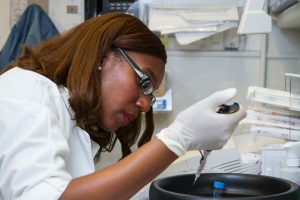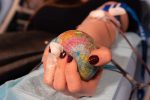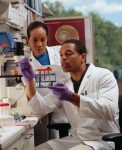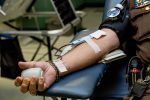Yes, it is a fact that the demand for phlebotomists has never been higher, but that does not mean that you should only pay attention to the certificates and courses.
You should also pay attention to your resume, which has an extraordinary impact on whether you will be employed or not.
It is essential that you do something that will help you stand out from the crowd, which is precisely the resume.
To depend solely on the training course you have taken is no longer enough.
Although there are more vacancies for phlebotomy, you will also find that more candidates are vying for the best jobs.
If you want to get a job, your resume should stand out from the competition, i.e., it should catch the employers’ eye.
No matter where you want to be employed and where you will send your resume, it should be a credible picture of your abilities.
Page Navigation
What Should a Phlebotomist’s Resume Contain?
Our team conducted an unusual study covering several medical institutions for what a phlebotomist resume should look like.
Our research will cover what a good phlebotomy summary should look like.
Let’s take a look at the basic sketches and what you need to complete for each separation.
You can use this guide if you are in the field of phlebotomy or have just finished training, and remember that it is never wrong to keep your CV up to date and add achievements or additional skills.
But we will focus mainly on how you can make your resume stand out when you are just starting as a phlebotomist and want to get a job right away.
We have divided our findings into several parts.
Resume objective: An important detail to mention is that everyone’s objective statement will probably be quite different, and most importantly, it is best to keep to no more than three sentences.
Consider what makes you want to be a phlebotomist and why to include it in your resume for the right purpose.
Every resume should start with something that will quickly get to the point and give the reader an insight into your abilities.
That is the objective, which should cover two significantly essential things:
- Describe in a few short sentences what kind of experience you expect to have as a phlebotomist.
Here you should state what you expect from your job as a phlebotomist and what work experience you would like to have.
This should not be longer than two sentences.
- Include short and long-term goals. The goals can be personal as well.
This should give your prospective employer an idea of your phlebotomy career goals.
These goals can be personal. Maybe your goal is to help a lot of people or start a career as a nurse.
Think about what you want in the short and long term and include them briefly.
And the most important thing is that the objective should not be longer than three to four sentences and that it should include what makes you want to be a phlebotomist and why.
Qualification summary: Sometimes, a summary of your qualifications is submitted instead of the objective.
It is usually done when you apply for a specific job in which you need to list your qualifications in that field.
Some resumes use a qualification summary instead of an objective statement.
The format you’ll be using is left to you.
But it is a good rule of thumb to use a qualification summary if you are applying for a job in a particular position.
This is because you can show your phlebotomy qualifications based on your job description.
Continuing to qualify is an incredible way to make a note of your strengths and abilities.
But you can do it in a specific job description’s way.
Namely, by listing your skills in this section, they will affect the employer’s mind, and they should include everything the potential employer is looking for.
Here you can list some of your abilities, and they need to meet the phlebotomist requirements.
For example, if the employer is looking for someone knowledgeable in the field of venipuncture, as well as finger sticks and CPR, to work in a busy hospital, the summary of your qualifications should look like this:
Experienced in the venipuncture field. Does well with finger sticks and works with butterfly needles and syringes. Team-player and work well under pressure. CPR training completed.
Skills and strengths: Do not forget to put everything you think characterizes you as competent for a phlebotomist.
With all that said, it’s up to you to add some useful things that will help your CV stand out from the crowd.
More personal skills and strengths can often attract the employer’s attention and make you hire someone else.
It is easy to think that the most critical part of a phlebotomy resume is your work history.
While this can make a big difference, you can strengthen your resume a bit by incorporating your strengths and skills.
It is essential to keep in mind that not all of these skills should reflect a phlebotomy career.
Sometimes, a trait or quality like punctuality can be more appealing to the employer than you might realize.
Therefore, do not be afraid to include what you think makes you unique from other potential employees.
Some of the characteristics you may mention are:
- Knowledge of various venipuncture fields and methods
- Team-player
- Highly organized
- 250+ successful blood draws
- Knowledge of medical terminology
- Experience
Many employers want to know where you used to work to contact him later to inquire about your work behavior and your meticulousness.
Here, you could mention some characteristics that you have had the opportunity to experience.
You can note one of the following:
- You are familiar with various phlebotomist equipment.
- You have performed routine blood draws.
- You have communicated with doctors about your duties.
- You have spoken with the patients about their condition.
Your to-do list will be unique to you.
If you want to get the job, it is essential to avoid generalizations about jobs in phlebotomy.
Or keep them small and focus on what you have done, appealing to the employer.
You can also include an internship if applicable, and you should note that you should start with your latest experience when you are listing your work history.
And for those who do not have work experience, you have to fill in that part in another way.
For example, put that while you have performed a significant number of successful blood draws, the number is usually around 100.
But since all the competition was in those training, there is no way you can stand out.
So you will need a job where you can gain experience, here we can mention:
Volunteering
Volunteering is probably the best way to gain experience with phlebotomy quickly.
It is more than just hospitals and clinics in great need of phlebotomists.
While plenty of organizations can not afford to employ full-time phlebotomists on staff and depend on phlebotomist volunteers, work as a volunteer will always be available.
Although these organizations do not always pay you, they are a great source from which you can gain and experience essential importance.
As a phlebotomy volunteer, you can work in plenty of medical facilities, including nursing homes, blood banks, the Red Cross, and veterans’ hospitals.
It is important to mention that working as a volunteer will not always be paid, but it will help you gain excessive experience.
Internship
If the medical facility does not hire you, you have the opportunity to get an internship, which means that you will not be paid for your work.
You will not have the employed phlebotomists’ responsibilities, but you will work with them and be their shadow.
On-the-Job Training
Even though you have already gone through phlebotomist training, you will also need to visit on-the-job training as well, and this is because, in the regular training course, you work on a mannequin arm.
In contrast, here, you will have to work on a real person and under a supervisor’s supervision.
Hospital Training
Hospitals in particular need of phlebotomists as well
Many medical institutions have training programs to be able to employ the trainees that have completed the training.
And they will make these programs somewhat specific to their subject.
This includes things like your own security rules and procedures, etc.
You may be able to get a job at that particular hospital right away if you train this way.
Where to complete the training?
The next part of your phlebotomy resume should focus on where you completed your education/training.
It is essential for employers to have trained with an accredited program.
It is okay for your education to list the school/program you attended and when you were there.
It is also a good idea to list all the additional certifications you have. Not every country currently requires phlebotomists to complete a certification exam.
The most ambitious ones who’ve obtained a certification have often been chosen over their peers.
You can also start with a higher salary than an unauthorized technician.
If you have any other certifications, do not be afraid to mention them, such as CPR, etc.
Any additional qualifications to highlight your resume can be helpful as you have done with your work experience.
First, list your latest experience with training or schooling.
Then move on to the least recent.
Be sure to list them when you finish high school and the name of that school.
But it can be another thing that helps you stand out from the competition in your resume.
References
Although not always necessary, you can choose to include two or three testimonials at the bottom of your resume.
These should be added only after all other important information and details.
If the job you are applying for was to be filled out, they might already have room to list your recommendations.
Therefore, make sure that the references are consistent on both documents.
This would mean that you have to choose someone you trust and be honest about your skills.
You can choose who you want as a recommendation, but try not to make all the family members.
Probably the best for you is to mention someone you have worked with within the past.
For example, great resources could be former bosses or managers.
These types of people will give the potential employer the best idea of what you are like in the work environment.
Resume’s Format
There is no one perfect format to follow for your resume when composing.
You can go in the order we have listed in this article or try something different.
But there are a few specific things to keep in mind when considering formatting.
Always make sure your objective statement or qualification summary is at or near the top.
That will be the first thing the employer reads to get a better idea of who you are.
Make it easy to find right away.
Highlight your best characteristics as well as your knowledge, and keep in mind that the employer has tons of resumes to review, so if you want to get hired, keep it simple.
They are more likely to read the top half of your resume.
If you can show the best parts of your job and education there, you can arouse their interest.
Consider putting your education/training ahead of your work history if you do not have work experience.
This is a subtle way to emphasize the knowledge you have first.
Does the Look of the Resume Matter?
It is essential to start by choosing a theme that helps you stay noticed but still look professional.
Something elegant with light colors is a great way to make your resume look different enough from someone else’s.
The most important thing is to put the most relevant information at the top of the summary because some employers would usually read the first 2 or 3 sentences, and if they do not see something special, they might not even read what follows.
Whether you put your contact information, the employer should be able to see it clearly to attract easily.
Here we can also say that you can go for a more modern approach and include your image and a few more personal details about yourself.
Some employers value this approach because it allows them to find out more about you before they need to call you for an interview, etc.
There are plenty of different ways to design your resume.
The best thing you can do is to do it yourself.
While using a template can help you, do not just choose a template that lists your strengths and experience and nothing else.
With all of the above, you need to consider a few things that can help boost your resume a bit.
It should not be too loud and confusing, but it is okay to include some color to be noticed.
It should be a credible reflection of who you are and your sense of professionalism.
Although there is a high demand for phlebotomists, many people are applying for these jobs.
It is essential to do as much as you can to show why you may be a better job candidate than anyone else.
So a substantial biography is critical.
Fortunately, it is not too complicated to compile a solid resume after considering the format.
By keeping things short and straightforward and highlighting your best qualities, you can create an impressive document.
With that in mind, we can say that the perfect thing is here for you.
An accurate resume can help you get it early and start your career as a phlebotomy technician.
What Should Your Resume Not Look Like?
The most important thing is not to lie about your abilities because lies come to light quickly.
Then you must not use language in the first person because it may sound unprofessional.
Please do not focus on using medical terms because it does not bring you any extra points.
Many people fall into the trap of using long, complicated words, which employers do not like because they have many resumes to check and read.
The simpler, the better.
The Bottom Line
From all that we have said at the top of the article, we can conclude that writing an ideal resume can feel overwhelming if you have never done something before.
Although you can use it in your resume, it will not help you stand out from any other candidate as everyone has to go through similar training procedures.
Most hospitals and medical facilities want the phlebotomists they hire to have at least some experience.
Otherwise, you may have to work under the supervisor’s supervision.
When you start as a phlebotomist, it cannot be easy to end your job experience.
The past jobs you have had can also be a great indicator that you are a dedicated worker.
But most medical employers want you to have experience in the healthcare industry.
During training, you must perform very successful venipunctures.
Each program has a different number that the student must reach to pass.
But it is usually over 100.
There are some tips you can use to make phlebotomy last longer.
You need to develop a resume that will help you stand out from the crowd.
It is no longer enough to highlight the training course you took.
Although there are more vacancies for phlebotomy, you will also find that more candidates are vying for the best jobs.
Phlebotomists can work in various types of organizations.
And it is not too important where you are applying for, the important part is that you need to make sure that your resume is a credible reflection of your abilities.
This page is also available in Spanish.










